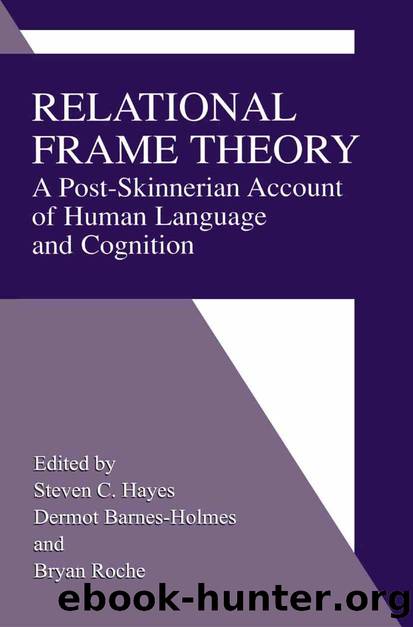Relational Frame Theory by Steven C. Hayes & Dermot Barnes-Holmes & Bryan Roche

Author:Steven C. Hayes & Dermot Barnes-Holmes & Bryan Roche
Language: eng
Format: epub
Publisher: Kluwer Academic Publishers 2001
Published: 2015-02-14T00:00:00+00:00
7.5.1. The Three Verbal Others
Perspective-taking leads to both the development of the self and to an elaboration of the verbal other. Perspective-taking can establish three types of verbal other: (i) other as verbal relations about the stable content of the other; (ii) other as verbal relations about the ongoing process of knowing in the other; and (iii) other as verbal relations about the context of verbal relations in the other. Stated another way, verbal relations can lead to a conceptualized other, a knowing other, and a transcendent or conscious other.
The conceptualized other is the normal verbal construction of the listener. The example given above about how one talks about relational frames is an issue of the conceptualized other. âCognitive psychologists are like x, y, and zâ is a verbal construction of the stable content of othersâ views, history, actions, preferences, and so on. In most verbal interactions, the conceptualized other serves as a Crel for the speakerâs behavior, at least to a degree.
The knowing other is more fluid because it is based on a moment-to-moment construction of reactions of the other. This happens commonly in conversation, especially with friends or others who are willing to share their reactions openly, or with those whom one knows well enough to âreadâ their expressions and gestures. Successful psychotherapy is often dependent on this level of verbal construction of the other. This level is relevant even to monodies, however, and effective public speakers that are said to be able to âreadâ their audiences are controlled in part by their moment to moment construction of the audiencesâ reactions. Sometimes input into this level is deliberately evoked by the speaker (e.g., âdid I just offend you?â or âyou just thought of your Dadâs death, didnât you?â). A sense of the other as process is necessary for the ongoing modulation of the speakerâs behavior.
A sense of the transcendent other is relatively uncommon, occurring most often in religious, intimate, or therapeutic relations. This occurs when the speaker is psychologically connected to the listener as a purely conscious person. In this aspect, the speaker and listener are one, since âHERE and NOWâ is imputed to be a singular event (i.e., one cannot be HERE and NOW, simultaneously, at different times and places). Perhaps for this reason, the level of self-as-context is associated with a sense of the transcendent other â the two go hand in hand. The difference between speaker behaviors regulated by the verbal construction of a conceptualized versus a knowing listener, is fluidity and modulation. The difference between these forms of communication and that controlled by the verbal construction of a transcendent other, is openness and defusion from the literal importance of content. That point will be clearer after we address these issues in Chapters 12 and 13.
Desynchrony between different kinds of verbal communication in a given speaker may be traced in part to the role of the verbal construction of the other. For example, a person can be very effective in instrumental verbal requests made in
Download
This site does not store any files on its server. We only index and link to content provided by other sites. Please contact the content providers to delete copyright contents if any and email us, we'll remove relevant links or contents immediately.
The Art of Thinking Clearly by Rolf Dobelli(10234)
The 5 Love Languages: The Secret to Love That Lasts by Gary Chapman(9607)
Mindhunter: Inside the FBI's Elite Serial Crime Unit by John E. Douglas & Mark Olshaker(9214)
Becoming Supernatural by Dr. Joe Dispenza(8127)
Nudge - Improving Decisions about Health, Wealth, and Happiness by Thaler Sunstein(7622)
The Road Less Traveled by M. Scott Peck(7525)
Enlightenment Now: The Case for Reason, Science, Humanism, and Progress by Steven Pinker(7243)
Mastermind: How to Think Like Sherlock Holmes by Maria Konnikova(7234)
Win Bigly by Scott Adams(7097)
The Way of Zen by Alan W. Watts(6513)
Factfulness: Ten Reasons We're Wrong About the World – and Why Things Are Better Than You Think by Hans Rosling(4696)
The State of Affairs by Esther Perel(4645)
Gerald's Game by Stephen King(4584)
Man's Search for Meaning by Viktor Frankl(4438)
The Confidence Code by Katty Kay(4192)
Thinking in Bets by Annie Duke(4154)
The Healing Self by Deepak Chopra(3478)
Hidden Persuasion: 33 psychological influence techniques in advertising by Marc Andrews & Matthijs van Leeuwen & Rick van Baaren(3476)
The Worm at the Core by Sheldon Solomon(3437)
